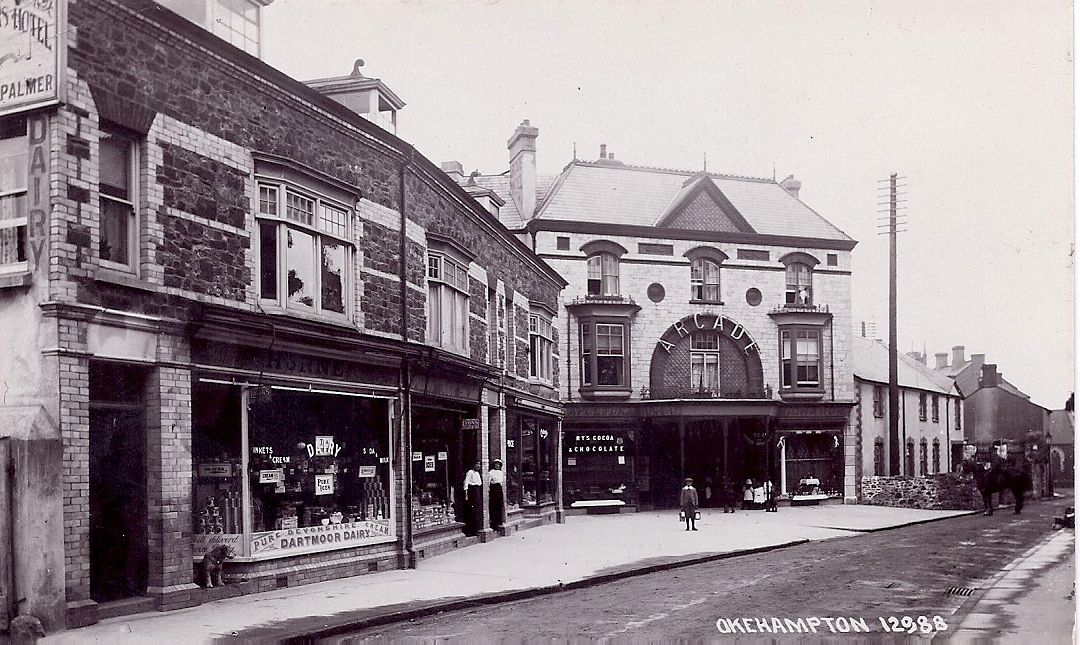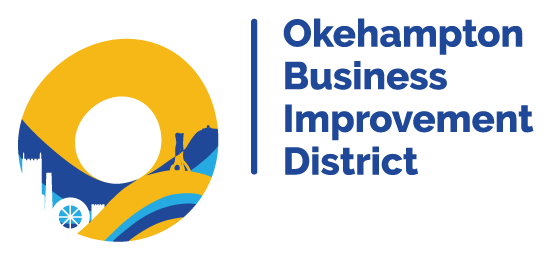

A brief history of Okehampton
Okehampton has seen many changes since the beginning of the 20th century and the Okehampton Community Archive group was set up to record and preserve these where possible.
A number of the shop facades in the town date from the late Victorian and Edwardian days. Fore Street as we know it to-day was divided by a third block of property known as Middle Row. In 1841 there were 38 shops in Fore Street and at that time until the early 1900s, from St James chapel to the traffic lights, all the premises on the left hand side, Boot’s etc, were called Back Street and those on the right hand side, Martin’s etc, were called Fore Street. The White Hart and Lloyds Bank to the London Inn were in The Parade and at West Street the main road was divided by a row of cottages and shops known as West Middle Row which were demolished in the 1930’s. The Arcade was built by Henry Geen from 1894 – 1900.
Okehampton was well known for it’s white cloth (serge) and in1840 it had the third highest number of looms in the country. Between 1760 and 1860 the town was a busy staging post for coach traffic between London and Cornwall, at which time various coaching houses and inns were established. The railway reached the town in 1871with the opening of the Southwest Railway line from Exeter.
There were four operating mills in the town well into the 1900s. In 1886 new sewerage works were completed at a cost of £2,300, in 1889 Electricity was introduced and in 1893 water was laid to the houses at a cost of £2,000.
Meldon Quarry opened in 1897 and from 1800 onward the Military Camp was used.
In1907 Sidney Simmons gave the Park to the town – which is still very much ‘the jewel in the crown’ for us all to enjoy today.

1760 - 1860
A Popular Staging Post
Between 1760 and 1860 the town was a busy staging post for coach traffic between London and Cornwall, at which time various coaching houses and inns were established.

1840
A town of many looms!
Okehampton was well known for it’s white cloth (serge) and in1840 it had the third highest number of looms in the country.

1841
38 shops on
Fore Street
In 1841 there were 38 shops in Fore Street and at that time until the early 1900s, from St James chapel to the traffic lights, all the premises on the left hand side, Boot’s etc, were called Back Street and those on the right hand side, Martin’s etc, were called Fore Street.

1871
The railway reaches Okehampton
In 1841 there were 38 shops in Fore Street and at that time until the early 1900s, from St James chapel to the traffic lights, all the premises on the left hand side, Boot’s etc, were called Back Street and those on the right hand side, Martin’s etc, were called Fore Street.

1886
Modern amenities added to the town
Okehampton was well known for it’s white cloth (serge) and in1840 it had the third highest number of looms in the country.

1894 – 1900
The arcade was built
In1907 Sidney Simmons gave the Park to the town – which is still very much ‘the jewel in the crown’ for us all to enjoy today.

1897
Meldon quarry
Meldon Quarry opened in 1897 and from 1900 onward the Military Camp was used.

1900S
Mills
There were four operating mills in the town well into the 1900s.

1907
Okehampton gains a park
In1907 Sidney Simmons gave the Park to the town – which is still very much ‘the jewel in the crown’ for us all to enjoy today.

1930'S
West Middle Row demolished
In 1841 there were 38 shops in Fore Street and at that time until the early 1900s, from St James chapel to the traffic lights, all the premises on the left hand side, Boot’s etc, were called Back Street and those on the right hand side, Martin’s etc, were called Fore Street.


 Everything Okehampton has been awarded funding by Devon County Council’s Devon Elevation Fund Community Renewal Fund to build a new Visit Okehampton website.
Everything Okehampton has been awarded funding by Devon County Council’s Devon Elevation Fund Community Renewal Fund to build a new Visit Okehampton website. 

